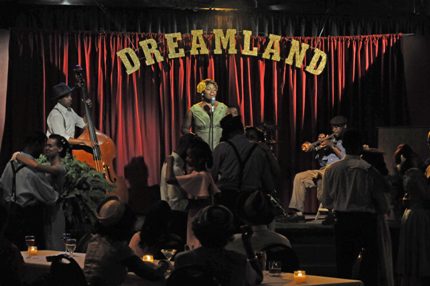
03 Apr 2017 AETN to premiere film on Little Rock ‘Dreamland’
Little Rock’s West 9th Street was once a vibrant, African-American business and entertainment district and home to Taborian Hall and the Dreamland Ballroom. The Arkansas Educational Television Network’s new documentary “Dream Land: Little Rock’s West 9th Street,” premiering at 7 p.m. Thursday, April 6, explores the street’s glory days and how Urban Renewal, the Eisenhower Interstate Program and more influenced its future.
“West 9th Street and the Dreamland Ballroom have patiently waited for their story to unfold so new audiences can connect to their historical past and unknown future,” said AETN Producer Tanisha Joe Conway. “Director Gabe Mayhan and I are excited and humbled to be a part of telling this history that has definite similarities to other streets and communities in Arkansas and across the country.”
Told by local residents and historians, “Dream Land” seeks to recognize, memorialize and share the significant past of the once thriving West 9th Street.
“To understand the whole story, you have to understand the birth of this street,” said Berna Love, author of “End of the Line” and “Temple of Dreams.” “This was an African-American community – West 9th Street was – for 100 years.
“This was the heart of not only Little Rock’s African-American community, this was the capital city, I guess you could say, of the African-American communities in Arkansas. This was a community that was born out of emancipation. This area was originally a federal encampment where emancipated slaves came; they flocked here.”
Taborian Hall, the only remaining historic structure on the street, stands as a living witness of the community’s former grandeur. Throughout the 1920s and 1930s, Taborian Hall housed varied and important black businesses, including professional offices, a USO, the Gem Pharmacy and the Dreamland Ballroom.
“There was every kind of business imaginable operating,” said Dr. John Graves, a historian from Henderson State University. “You would have barber shops. You’d have stable yards. You name it. Almost any kind of business you can imagine would be operating here on West 9th Street.”
By the 1930s, Dreamland Ballroom was host to musicians, dances, socials, concerts and
sporting events.
“When Dreamland became Dreamland is unclear, but we do know in 1933, it already had a name,” Love said. “They were already making a little heart shaped invitation with Modernistic Club, the Dreamland Ballroom.
“Then, in 1936, the Chicago Defender newspaper starts writing about the Dreamland Ballroom and how it’s going to be this music epicenter for all these musical acts that are coming through Little Rock.”
Dreamland Ballroom was firmly established as a stop on the “Chitlin Circuit,” which showcased regional and national African-American bands and stage shows.
“It’s where most of the black performers traveled,” said John Cain, local resident and activist and program director at KABF. “Here, Nashville, Beale Street in Memphis, Birmingham.
“They called it the Chitlin’ Circuit.”
The impact of federal programs such as Urban Renewal, school desegregation, the Housing Act of 1949 and the Eisenhower Interstate Program are also explored. “One of the things that Urban Renewal does is to build new public housing, which are nicer, which are more modern, and all those kinds of things, and use those, you know, incentives as instruments to move the black population away from traditional areas of residence into new areas of residence,” Dr. John Kirk, a historian from the University of Arkansas at Little Rock, said. “There’s all kinds of ways of manipulating things once you kind of break up the natural housing patterns.”
Though little remains of the street’s former glory, viewers will be taken on a historical journey from the late 1800s to today. To help bring the Dreamland Ballroom back to life, the documentary features special reenactments by Rodney Block and The Real Music Lovers, Bijoux, Detroit Johnny, Jazz R Us and dancers from the Tidwell Project, among others. A stroll down West 9th Street shows what remains today.
“This is a part of the American story,” Dr. Cherisse Jones-Branch, a historian from Arkansas State University, said. “We need to know about these communities – we need to understand that the communities were complex, the people were educated, that people had money, that people owned businesses, that they established and maintained important institutions in these communities.
“These are stories that people aren’t getting.”
“Dream Land: Little Rock’s West 9th Street” will repeat at 9 p.m. Monday, April 17. Major funding for the film was provided by the Arkansas Humanities Council and The Moving Image Trust Fund. Additional information is available at aetn.org/dreamland.











